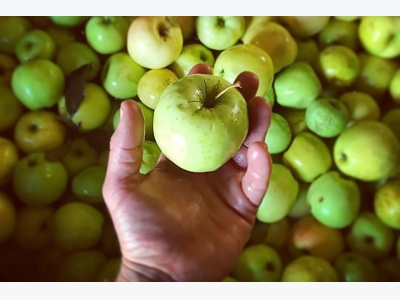Cropped: How to Grow Cider Apples

America is tossing back hard cider like a sailor on shore leave. Indeed, domestic sales of the gluten-free booze have nearly tripled since 2012, causing demand for cider apples to outstrip supply.
As a result, these barely edible bittersharp and bittersweet varieties currently fetch about 30 percent more, per bushel, than their fresh-eating cousins. Plus, because the harvest gets pressed, farmers can profit from fruit that might otherwise be considered ugly, overripe, or too small.
Cultivation
Cider apples prefer well-drained, acidic soil (with a pH between 5.0 and 6.8) and perform best in Zones 4 to 7. In Zone 7 or higher, you can plant bare-root trees in fall, assuming you’re able to find a source for them. Otherwise, take advantage of the harvest season to visit orchards and learn from growers and cider makers before planting when spring rolls around.
One thing you should definitely know: Most heirloom cider varieties have been grafted onto modern dwarf stock (‘Malling 9’ or ‘Budagovsky 9’), yielding trees that are short and easy to pick but have weak trunks that require trellising. So you’ll want to lay out your orchard like a vineyard: Plant the trees 5 feet apart in parallel rows 15 feet from one another, in holes just big enough to accommodate the roots. Along each row, sink 6-foot-tall posts every 20 feet, then string four wires horizontally between the posts, spacing the wires 18 inches from each other or the ground. Finally, spread a 2-inch layer of organic mulch around the saplings, snip them to a height of about 18 inches, and tie them loosely to the bottom wire.

Care
In spring or early summer, tie new branches and shoots to the nearest trellis wires. Throughout the summer, remove suckers (young growth) that emerge from the rootstock. In late winter or early spring, prune away any branches that prevent light from penetrating the tree’s canopy, as well as those that obscure the aisles between rows.
Unless your trees fail to grow at least a foot per year, withhold fertilizer until they begin to fruit. At that point, apply organic fertilizer annually, after spring pruning. And spray organic insecticides and fungicides (such as neem oil to control borers) on an as-needed basis.
Harvest
Roughly seven years after planting, your apples will finally be ripe for the picking, from August through October, depending on the cultivar (see “Types to Try,” above). Bear in mind that a year of heavy apple production is often followed by a relatively light one. You can even out the overall annual yield by adding different varieties over time. The trees also tend to drop fruit, which you can sell if your state regulations permit it. Market the harvest to cider makers fresh or pressed and stored in barrels (where it will remain stable for months)—or try brewing your own craft beverage.
Có thể bạn quan tâm
Phần mềm

Phối trộn thức ăn chăn nuôi

Pha dung dịch thủy canh

Định mức cho tôm ăn

Phối trộn phân bón NPK

Xác định tỷ lệ tôm sống

Chuyển đổi đơn vị phân bón

Xác định công suất sục khí

Chuyển đổi đơn vị tôm

Tính diện tích nhà kính

Tính thể tích ao hồ



 The Healing Garden: How to Grow 7 Medicinal…
The Healing Garden: How to Grow 7 Medicinal…  How to Plant a Food Forest This Winter
How to Plant a Food Forest This Winter